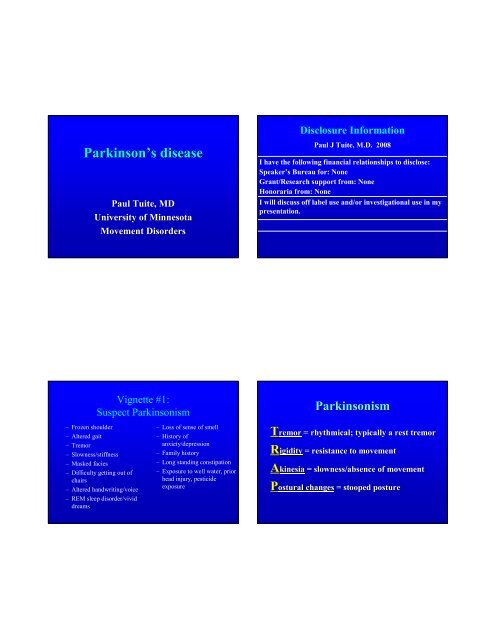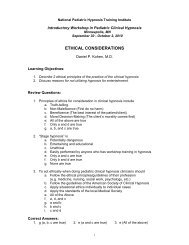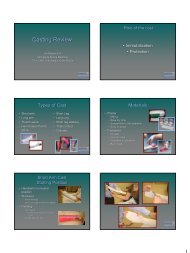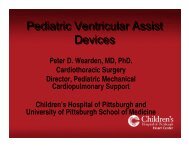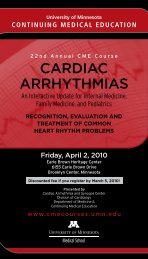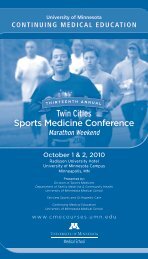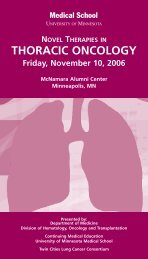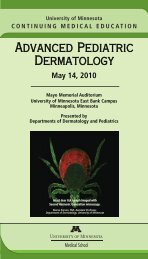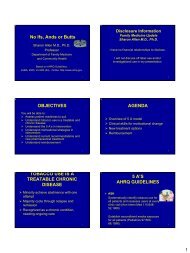Parkinson's disease - University of Minnesota Continuing Medical ...
Parkinson's disease - University of Minnesota Continuing Medical ...
Parkinson's disease - University of Minnesota Continuing Medical ...
You also want an ePaper? Increase the reach of your titles
YUMPU automatically turns print PDFs into web optimized ePapers that Google loves.
Disclosure Information<br />
Parkinson’s s <strong>disease</strong><br />
Paul Tuite, MD<br />
<strong>University</strong> <strong>of</strong> <strong>Minnesota</strong><br />
Movement Disorders<br />
Paul J Tuite, M.D. 2008<br />
I have the following financial relationships to disclose:<br />
Speaker’s Bureau for: None<br />
Grant/Research support from: None<br />
Honoraria from: None<br />
I will discuss <strong>of</strong>f label use and/or investigational use in my<br />
presentation.<br />
Vignette #1:<br />
Suspect Parkinsonism<br />
Parkinsonism<br />
– Frozen shoulder<br />
– Altered gait<br />
– Tremor<br />
– Slowness/stiffness<br />
– Masked facies<br />
– Difficulty getting out <strong>of</strong><br />
chairs<br />
– Altered handwriting/voice<br />
– REM sleep disorder/vivid<br />
dreams<br />
– Loss <strong>of</strong> sense <strong>of</strong> smell<br />
– History <strong>of</strong><br />
anxiety/depression<br />
– Family history<br />
– Long standing constipation<br />
– Exposure to well water, prior<br />
head injury, pesticide<br />
exposure<br />
Tremor<br />
= rhythmical; typically a rest tremor<br />
Rigidity<br />
= resistance to movement<br />
Akinesia<br />
= slowness/absence <strong>of</strong> movement<br />
Postural changes = stooped posture
Resting Tremor<br />
Rigidity<br />
Spasticity<br />
Akinesia/Bradykinesia
Postural Changes Vignette #1:<br />
So it is Parkinsonism, what next?<br />
– Determine degree <strong>of</strong> disability from symptoms/signs<br />
– Decide on <strong>disease</strong> subtype<br />
• Tremor predominant<br />
• Akinetic-rigid variant<br />
– Age <strong>of</strong> individual?<br />
– Are they working?<br />
– Do they have pre-existing addictions/compulsions?<br />
– Sleep deprivation, RBD, Sleep apnea, driving for work?<br />
– Does insurance cover their medications?<br />
– Do they have pre-existing lower extremity edema?<br />
– Is there renal dysfunction? relates to ropinirole<br />
– Are they demented or have MCI? avoid certain drugs<br />
What if patients don’t want a Rx?<br />
Role <strong>of</strong> Coenzyme Q10 (CoQ)<br />
• Physical, Occupational & Speech Therapy<br />
– Training BIG THERAPY (Dr. Becky Farley)<br />
• Potentially useful compounds<br />
– Coenzyme Q10 400 mg TID (1200 mg/d) $$$$<br />
– Omega 3<br />
– Creatine<br />
– Selenium
Potentially Disease Altering<br />
Isradipine (Dynacirc®) shown to affect<br />
<strong>disease</strong> progression in mouse model <strong>of</strong> PD.<br />
Blockade <strong>of</strong> Ca channels forced utilization <strong>of</strong><br />
less toxic Na channels<br />
Symptomatic Medications<br />
– Dopamine agonists:<br />
• Rotigotine (Neupro) patch<br />
• Ropinirole (Requip) TID or QD (soon)<br />
• Pramipexole (Mirapex) TID<br />
– MAO b inhibitors:<br />
• Selegiline (Eldepryl) QD or AM & Noon<br />
• Rasagiline QD<br />
– Glutamate modulation:<br />
• Amantadine (Symmetrel) QD - TID<br />
– Anticholinergics:<br />
• Trihexyphenidyl (artane) BID<br />
• Benztropin (cogentin) BID<br />
Carbidopa/Ldopa<br />
Sinemet<br />
Substantia Nigra<br />
levodopa<br />
How do medications work?<br />
DA<br />
Amantadine*<br />
Selegiline<br />
Rasagiline<br />
GABA<br />
Dopamine agonists<br />
bromocriptine<br />
pramipexole<br />
ropinirole<br />
apomorphine<br />
rotigotine<br />
SHORT ACTING—<br />
IMMEDIATE RELEASE LEVODOPA<br />
GENERIC VS. TRADE<br />
carbidopa/levodopa Sinemet® (carbidopa/levodopa)<br />
10/100 25/100 25/250 10/100 25/100 25/250<br />
BBB<br />
carbidopa<br />
benserazide<br />
tolcapone<br />
entacapone<br />
ACh<br />
trihexiphenidyl<br />
Striatum<br />
www.wemove.org
SHORT ACTING—<br />
IMMEDIATE RELEASE LEVODOPA<br />
Carbidopa/levodopa: generic or trade<br />
Versus<br />
Parcopa: levodopa in a disintegrating tablet<br />
LONG ACTING LEVODOPA<br />
GENERIC OR TRADE<br />
EXTENDED RELEASE (ER)<br />
CONTINUOUS<br />
RELEASE (CR)<br />
SUSTAINED RELEASE (SR)<br />
PILLS NOT SHOWN<br />
25/100 ER 25/100 ER<br />
25/100 SR<br />
50/200 ER 50/200 SR<br />
0.05<br />
Rotigotine (Neupro)<br />
2,4,6 & ?8 mg<br />
2.0 mg<br />
DOPAMINE AGONISTS<br />
COMT INHIBITORS<br />
MIRAPEX<br />
REQUIP<br />
PARLODEL<br />
APOMORPHINE<br />
ROTIGOTINE
Monitoring Dopamine Agonists<br />
Pharmacorama.com<br />
Britaject<br />
http://www.shef.ac.uk/misc/groups/epda/drug4.htm<br />
• Addictions:<br />
gambling, internet, sex, shopping, sports,<br />
antiparkinsonian medications, eating, others<br />
• Obsessive compulsive behaviors: OCBs; Punding:<br />
Cleaning/tidying, Do-it-yourself, Gardening,<br />
Collecting things, Repairing/dismantling (computers<br />
televisions, radios); Sorting, e.g., papers, through<br />
drawers/handbag; On the computer<br />
Reward Pathways<br />
Leg/Foot Edema (Swelling)<br />
LIMBIC<br />
Nucleus accumbens<br />
interacts with<br />
dopaminergic agents,<br />
cocaine, opiates (heroin)<br />
and marijuana (THC)<br />
LIMBIC<br />
http://bill.innanen.com/parkinsons/graphics/200111/uglyFoot.jpg
DAYTIME SOMNOLENCE<br />
Stimulants<br />
• Sleep deprivation<br />
– Sleep apnea<br />
– Nocturia<br />
– Nocturnal akinesia<br />
– Insomnia<br />
• Sedating medications<br />
– Dopamine agonists<br />
– Benzodiazepines<br />
– Others<br />
• Dementia<br />
MONOAMINE OXIDASE TYPE B<br />
INHIBITORS<br />
Anticholinergic Medications<br />
Artane® (trihexyphenidyl)<br />
Cogentin® (benztropine)<br />
RASAGILINE (AZILECT®)<br />
SELEGILINE (ELDEPRYL®)<br />
0.5 and 1 MG<br />
Rasagiline<br />
5 MG<br />
Tyramine Diet restriction<br />
Avoid SSRIs serotonin syndrome<br />
Meperidine – selegiline interaction<br />
Avoid decongestants BP effect<br />
Anti-SLUD: dry mouth, dry<br />
eyes/blurred vision, decr voiding,<br />
constipation, light-headedness,<br />
altered memory
Glutamate Modulating Medications<br />
Symmetrel® (amantadine)<br />
<br />
Natural History <strong>of</strong> Parkinson’s <strong>disease</strong><br />
Neuroprotective Rx Research Symptomatic Medication Rx<br />
DBS surgery<br />
-5 0 .5 - 1 1-1.51.5 4-10<br />
8-15<br />
12-20<br />
20<br />
rimantadine<br />
Flumadine®<br />
(rimantadine)<br />
Leg swelling,<br />
livedo reticularis,<br />
confusion, etc.<br />
Livedo reticularis<br />
Skin changes<br />
Symptoms<br />
Treatment<br />
Falls, swallowing,<br />
first<br />
begins<br />
bladder, cognitive<br />
appear<br />
problems, etc.<br />
Onset <strong>of</strong><br />
Diagnosis is<br />
<strong>disease</strong><br />
made<br />
Motor Complications<br />
(dyskinesias/fluctuations) begin<br />
Walker,<br />
cane,<br />
wheelchair<br />
for balance<br />
Motor Features As PD<br />
Advances<br />
Motor fluctuations: varying states <strong>of</strong><br />
mobility, which may or may not occur at<br />
a specific time in relation to their<br />
medication<br />
Dyskinesias: involuntary movements (not<br />
tremor), record when they occur -<br />
specifically in relation to their medication<br />
& time <strong>of</strong> day<br />
Often after 5-10 years<br />
motor fluctuations and dyskinesias occur
Non Motor Difficulties in PD<br />
Vignette #2<br />
• Vision<br />
• Gastrointestinal<br />
• Musculoskeletal<br />
• Skin<br />
• Respiratory<br />
• Neuropsychiatric<br />
• Sleep<br />
• Bladder<br />
• Orthostatic<br />
hypotension<br />
• 52 yo race car mechanic, lives alone, no financial<br />
support other than from working<br />
• PD: 16 to 17 years; severe motor fluctuations,<br />
significant "<strong>of</strong>f" times, as well as prominent<br />
dyskinesias that can be disabling at times.<br />
• He continues to struggle significantly with<br />
depression.<br />
• Medications<br />
– Sinemet 25/100, 1 to 6 tablets per day;<br />
– Dopamine agonist 0 to 10 times per day;<br />
– Amantadine 100 mg 1 to 2 per day.<br />
DBS and Parkinsonian Sxs:<br />
Features helped by surgery (checked)<br />
DBS Surgery<br />
Motor Difficulties<br />
Tremor<br />
Slowness<br />
Balance/Falls<br />
Fluctuations/Dyskinesias<br />
Off-related freezing<br />
Neuropsychiatric<br />
Anxiety/Depression<br />
Dementia<br />
Hallucinations<br />
Psychosis<br />
Autonomic Dysfunction<br />
Bowel/Bladder<br />
Orthostatic Hypotension<br />
Other<br />
Sleep apnea/RBD<br />
Weight/diet/dentition<br />
Dermatological<br />
Ophthalmologic<br />
Musculoskeletal<br />
Factors determining who should go for surgery:<br />
– Age: < vs. > 70 years<br />
– Concomitant medical conditions<br />
– Diagnosis: PD vs. atypical PD<br />
– Disabling features: Motor vs. Non-motor<br />
– Duration <strong>of</strong> <strong>disease</strong><br />
– Proximity to health care<br />
– Family dynamics<br />
– Objectives <strong>of</strong> surgery
Presurgical Evaluation<br />
• Neurological consultation<br />
• Motor testing<br />
• MRI scan<br />
• Cognitive assessment<br />
• Neurosurgical consultation<br />
Screening MRI:<br />
Normal vs. Strokes<br />
<br />
<br />
DBS Safety/Care Issues<br />
• Avoid diathermy (electrically induced heat:<br />
heating pads, deep ultrasound, etc.) near the<br />
implanted pulse generator (IPG, aka battery)<br />
• Device may be turned <strong>of</strong>f with theft detectors,<br />
refrigerator magnets, etc.<br />
• Monitor for infection, etc.<br />
• Monitor for technical difficulties, etc.<br />
• Avoid MRI scans (unless guided by DBS team)<br />
• Dental care
Vignette #3<br />
Initial Symptoms<br />
Dementia<br />
Years Later<br />
Parkinsonism<br />
• 72 yo w/ 4 yr h/o parkinsonism<br />
• Present meds:<br />
– Sinemet 25/250 TID<br />
– Selegiline 5 QAM<br />
• Issues:<br />
– Falls/Gait instability<br />
– Hallucinations to some meds<br />
Parkinsonism<br />
Parkinsonism<br />
Dementia<br />
Dementia<br />
TIME (years)<br />
Dementia<br />
Alz<br />
Disease<br />
Lewy<br />
Body<br />
Dementia<br />
PD<br />
Dementia<br />
Lewy Body Dementia<br />
Lewy Body Dementia<br />
Major Criteria<br />
Parkinsonism<br />
Fluctuations<br />
Vis Hallucinations<br />
Minor Criteria<br />
Delusions<br />
Falls<br />
Anti-DA sensitivity<br />
If 3 or > features 75% it is LBD<br />
LBD Drawings<br />
Alzheimer Drawings
ANTIPSYCHOTIC<br />
MEDICATIONS<br />
MEMORY ENHANCING MEDICATIONS<br />
• Falls<br />
Suspect Diagnoses Other<br />
Than PD if Seen Early<br />
• Cognitive changes<br />
• Prominent sexual or bladder dysfunction<br />
• Lack <strong>of</strong> response to adequate Rx trial<br />
• Symmetric onset<br />
• Early bulbar dysfunction
Falls<br />
– Executive dysfunction: not thinking first<br />
– Orthostatic hypotension<br />
– Freezing: feet stick to the floor<br />
– Vertigo: benign positional<br />
– Impaired vision<br />
– Sensory problems<br />
– Sensory-motor integration difficulties<br />
Red Flags at Any Time During<br />
the Course <strong>of</strong> the Condition<br />
Cortical Sensory Signs<br />
Alien Limb/unilateral apraxia<br />
No response to L-dopa<br />
Impaired vertical eye movements<br />
Cerebellar features<br />
Corticobasal<br />
Degeneration
Gait Difficulties: Is It Really PD?<br />
Multifactorial Gait Disorder<br />
• Multifactorial gait disorder<br />
• Normal pressure hydrocephalus<br />
• Vascular parkinsonism<br />
• Progressive supranuclear palsy<br />
• Lewy body dementia<br />
• Multiple system atrophy<br />
• Corticobasal degeneration<br />
• Medication induced parkinsonism<br />
• Cervical spondyloarthropathy<br />
Continuum: Geriatric Neurology<br />
Normal Pressure Hydrocephalus (NPH)<br />
Vascular Gait Disorder<br />
Continuum: Geriatric Neurology<br />
Continuum: Geriatric Neurology
• Supranuclear palsy<br />
• Falls early in course<br />
• Dysarthria<br />
• Cognitive impairment<br />
• Emotional<br />
incontinence<br />
• Abducted arms when<br />
ambulating: “gunslinger’s<br />
gait”<br />
PSP<br />
Dudley Moore<br />
PSP: Abnormal<br />
Voluntary Eye Movements<br />
Baylor U<br />
Progressive Supranuclear Palsy


